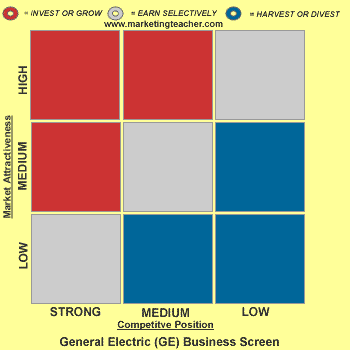The General Electric Business Screen
The General Electric Business Screen was originally developed to help marketing managers overcome the problems that are commonly associated with the Boston Matrix (BCG), such as the problems with the lack of credible business information, the fact that BCG deals primarily with commodities not brands or Strategic Business Units (SBU’s), and that cashflow if often a more reliable indicator of position as opposed to market growth/share.
For market attractiveness:
- Size of market.
- Market rate of growth.
- The nature of competition and its diversity.
- Profit margin.
- Impact of technology, the law, and energy efficiency.
- Environmental impact.
…and for competitive position:
- Market share.
- Management profile.
- R & D.
- Quality of products and services.
- Branding and promotions success.
- Place (or distribution).
- Efficiency.
- Cost reduction.
At this stage the marketing manager adapts the list above to the needs of his strategy. The GE matrix has 5 steps:
- One – Identify your products, brands, experiences, solutions, or SBU’s.
- Two – Answer the question, What makes this market so attractive?
- Three – Decide on the factors that position the business on the GE matrix.
- Four – Determine the best ways to measure attractiveness and business position.
- Five – Finally rank each SBU as either low, medium or high for business strength, and low, medium and high in relation to market attractiveness.
Now follow the usual words of caution that go with all boxes, models and matrices. Yes the GE matrix is superior to the Boston Matrix since it uses several dimensions, as opposed to BCG’s two. However, problems or limitations include:
- There is no research to prove that there is a relationship between market attractiveness and business position.
- The interrelationships between SBU’s, products, brands, experiences or solutions is not taken into account.
- This approach does require extensive data gathering.
- Scoring is personal and subjective.
- There is no hard and fast rule on how to weight elements.
- The GE matrix offers a broad strategy and does not indicate how best to implement it.
The GE Business Screen introduces a three by three matrix, which now includes a medium category. It utilizes industry attractiveness as a more inclusive measure than BCG’s market growth and substitutes competitive position for the original’s market share.

So in come Strategic Business Units (SBU’s). A large corporation may have many SBU’s, which essentially operate under the same strategic umbrella, but are distinctive and individual. A loose example would refer to Microsoft, with SBU’s for operating systems, business software, consumer software and mobile and Internet technologies.
Growth/share are replaced by competitive position and market attractiveness. The point is that successful SBU’s will go and do well in attractive markets because they add value that customers will pay for. So weak companies do badly for the opposite reasons. To help break down decision-making further, you then consider a number of sub-criteria:
